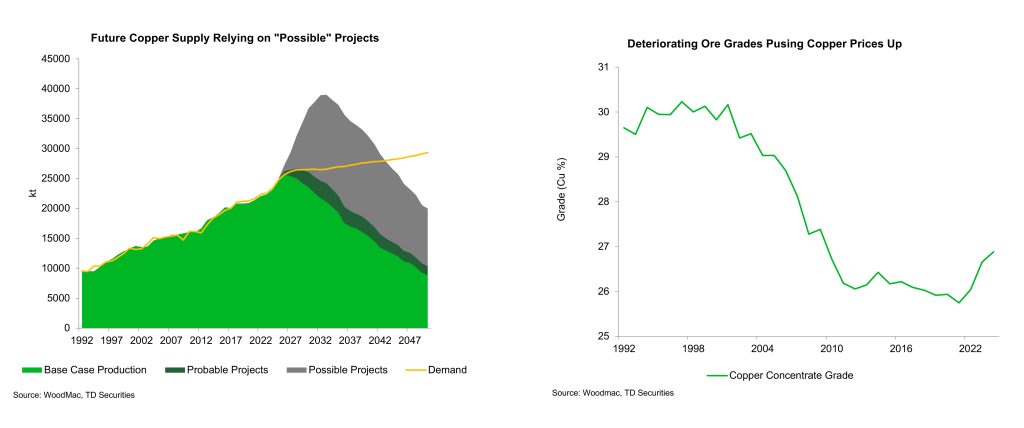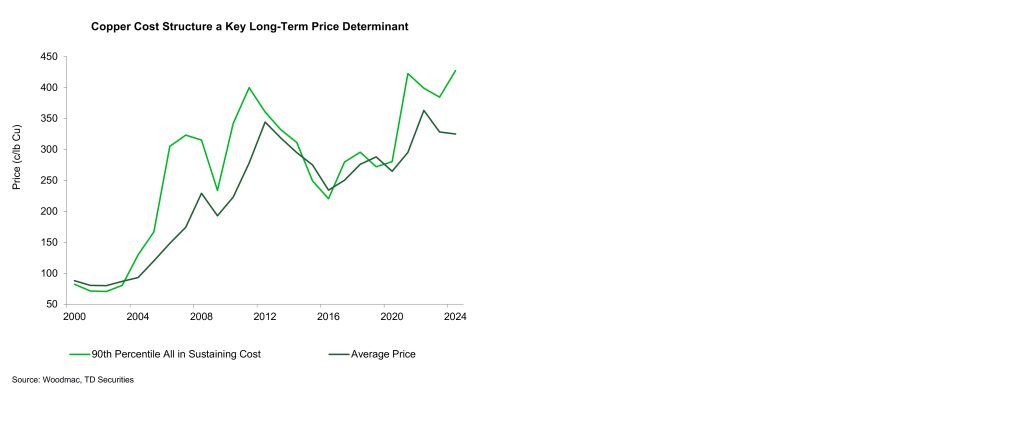- With a few exceptions, copper had outperformed most other assets during the first half of 2024 – it bested the super-charged US equity market, gold, and most of its industrial metal peers. Interest from the financial community swelled amid copper’s supercycle narrative stemming from the energy transition, optimism surrounding Chinese demand, and a reduction in supply expectations in the aftermath of a politically-driven mine shuttering in Panama.
- After hitting a high of US$11,105/t in May and trading in the $10,000/t territory in July, the red metal has recently plunged to a much lower trading range around $8,900/t. The failure to deliver an anticipated robust stimulus by China’s government, concerns the US economy may slow much more than anticipated, weakening battery electric vehicle (BEV) sales, and higher rates from BoJ, are all reasons why copper has fallen out of favor with speculative investors recently.
- With hopes waning that China will introduce new robust economic stimulus, a pending deterioration in US economic activity, weakness in Europe, along with materially less enthusiasm for the very copper intensive BEVs, the copper market may continue to be quite loose well into 2025. With the risk of a surplus materializing next year, investors still have room to cut their substantial, long LME market exposure, keeping prices subdued.
- While we don’t anticipate an additional deep sustained correction given pending Fed easing and some cyclical demand improvements, the recovery is projected to be relatively anemic over the next twelve months. As such, prices are likely to have a hard time breaking the $10,000 mark for a sustained period next year, delaying the oft-cited copper supercycle.
China Weakness, US Recession Fears, BOJ Unexpected Tightening Knocks Copper Off Highs
The outsized interest from speculative money managers such as specialist hedge funds, which was supported by copper’s long-term bullish narrative from the energy transition and projected deficit conditions for 2024, prompted the rally earlier this year. Prices rallied to a high of US$11,105/t in May and continued trading in the $10,000/t territory in July. As such, until quite recently copper outperformed US equities, the bond market, gold, and other industrial metals.
This was despite the fact there was very little evidence of strong demand or tightness on the ground in China. Despite the projections about an undersupply of the metal in the future, there seems to be more than enough of it available right now, in large part because China is copper’s biggest buyer. Data from bourses around the world, including the London Metals Exchange, Shanghai, and CME, show that aggregate inventories of the metal have been rising to their highest levels since May 2024.
Copper’s outperformance has abruptly ended in recent days. Time spreads have collapsed since May, and the front end of the curve is quite depressed. With China not delivering the expected stimulus, which the market hoped would get it out of its housing and broader economic funk, fears are growing that along with a likely slowdown in the US, these developments will prompt a decline in copper demand growth.
This, along with an unexpected hike in the BoJ policy rate at the end of July, prompted investors to reduce their yen-carry exposure, which reduced leverage and thus sapped enthusiasm to hold long positions in the red metal and drove prices lower. This drop in prices precipitated a negative knock-on effect from technical traders and systematic trend following funds (CTAs).
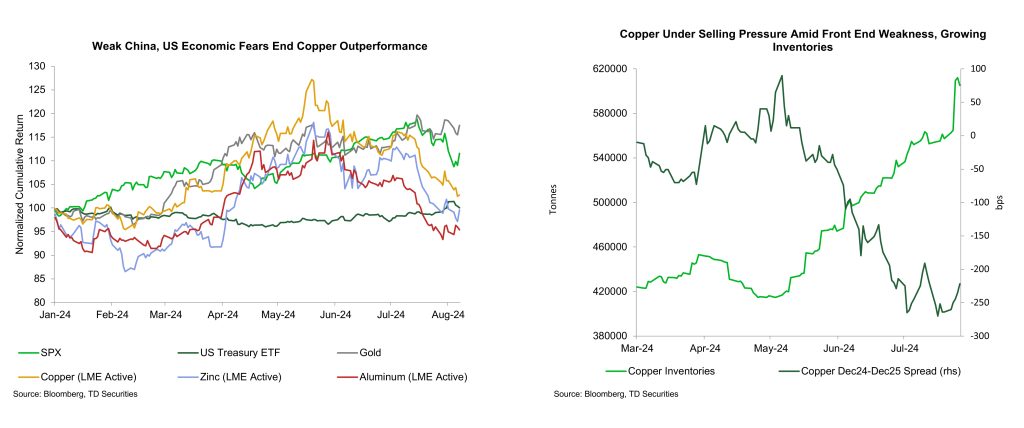
Surplus Possible in 2025
With economic weakness becoming a defining feature of the world’s two largest economies, concerns are rising that demand (construction, industrial) will be slow and that the copper market will not be tight next year. Indeed, we are projecting a modest surplus, which typically means that any price recovery will be much more muted than many in the market were projecting just a few weeks ago.
In addition to China’s economy sputtering, the US is leaning into protectionism, imposing tariffs against Beijing on everything from electric vehicles, to batteries, to semiconductors and solar modules. The European Union announced tariffs on Chinese BEVs in July, with Canada also in a well-defined protectionist mode. At the same time, mine supply is set to peak in 2026 as output is expected to grow 4.6% and 4.8% in 2025 & 2026 — much faster than demand, which is projected to increase just over 3% on average over the next two years.
While we don’t anticipate a sustained correction, given a pending Fed easing and some cyclical demand improvements, we do project a relatively anaemic recovery from the current lows over the next twelve months. Prices will likely have a hard time breaking the $10,000/t mark for a sustained period next year, delaying the oft-cited pending copper supercycle. But there is a risk of a serious rout should the US fall into recession. Copper has historically dropped 10-60% peak-to-trough during a contraction.
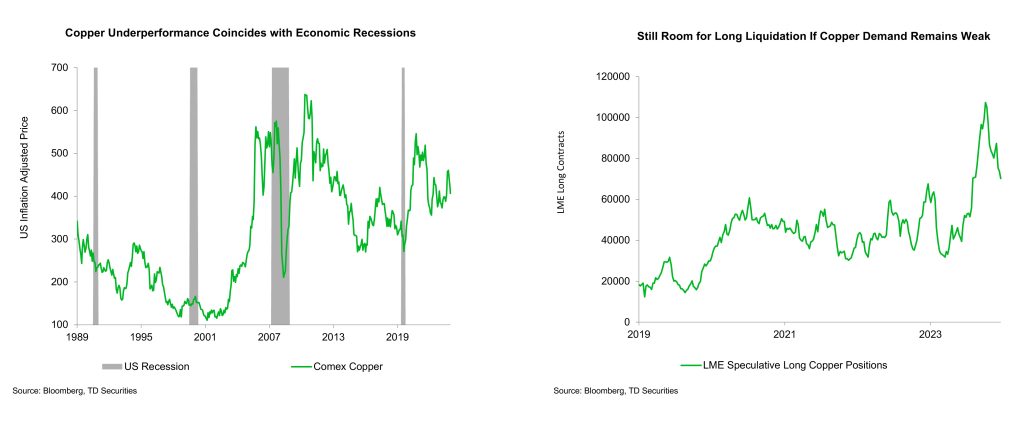
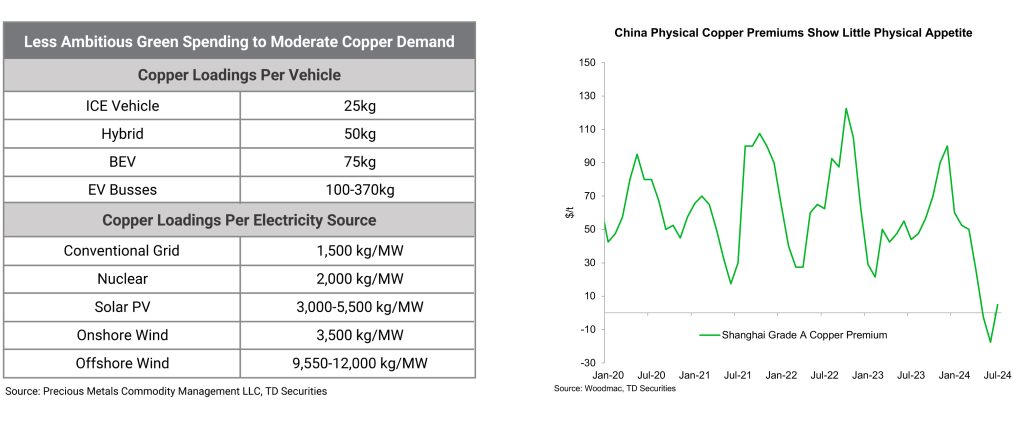
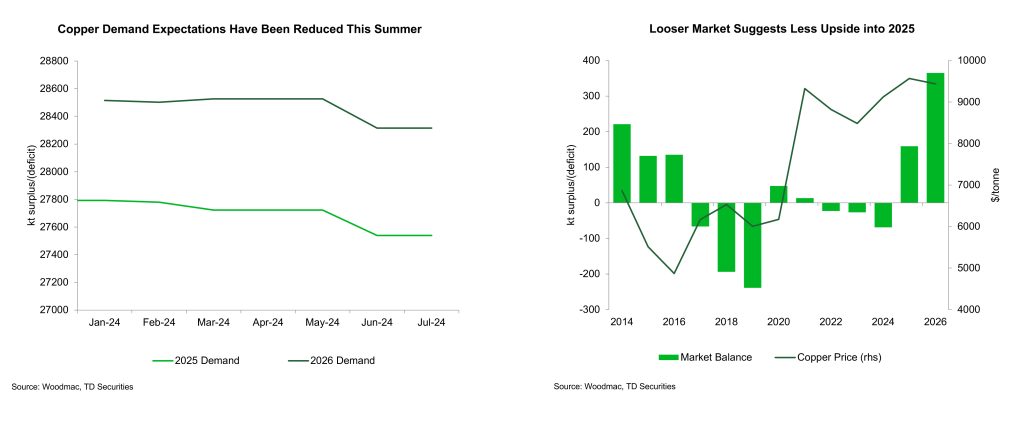
Copper Supercycle Interrupted Not Eliminated
After mine supply peaks in 2026 and from then on, supply will be required from new projects to satisfy the demand that will be underpinned by the Energy Transition. Notwithstanding a period of above-average mine output growth over the near-term, copper still faces a structural deficit in the refined metal market. With stocks in days of consumption trending below the long-term average of 65 days through to 2033, according to Woodmac, this tightness should serve as significant price support.
The challenge will be the industry’s ability to construct new mines on schedule to match demand growth. With a poor economy over the next 12 months, we are likely to see a loss of appetite for new investment in mining capacity, suggesting that proposed projects are delayed or do not find investors. If demand grows and supply does not, prices may well shoot higher.
At the same time, poor ore quality, difficult geographies, skilled labor scarcities, and high capital equipment costs all suggest that copper prices may need to be significantly higher to incentivize new mine construction.
In addition, miners are faced with resource nationalism that may take the form of much higher taxes or other royalties to governments, geopolitical disturbances such as war, or permitting issues (e.g. Panama closure of a major copper mine recently). This suggests that these risks should add a premium to long- term copper prices in the more distant future, as they will limit primary growth and escalate costs.
Of course, there are risks that demand growth does not materialize as expected due to politics, a lack of social acceptance, high cost and infrastructure challenges. But overall, we do think that the risks point to higher prices for copper in the longer-term, but not before a period of weakness in the next year or so, as elevated inventories and weaker economic growth weigh on prices.
